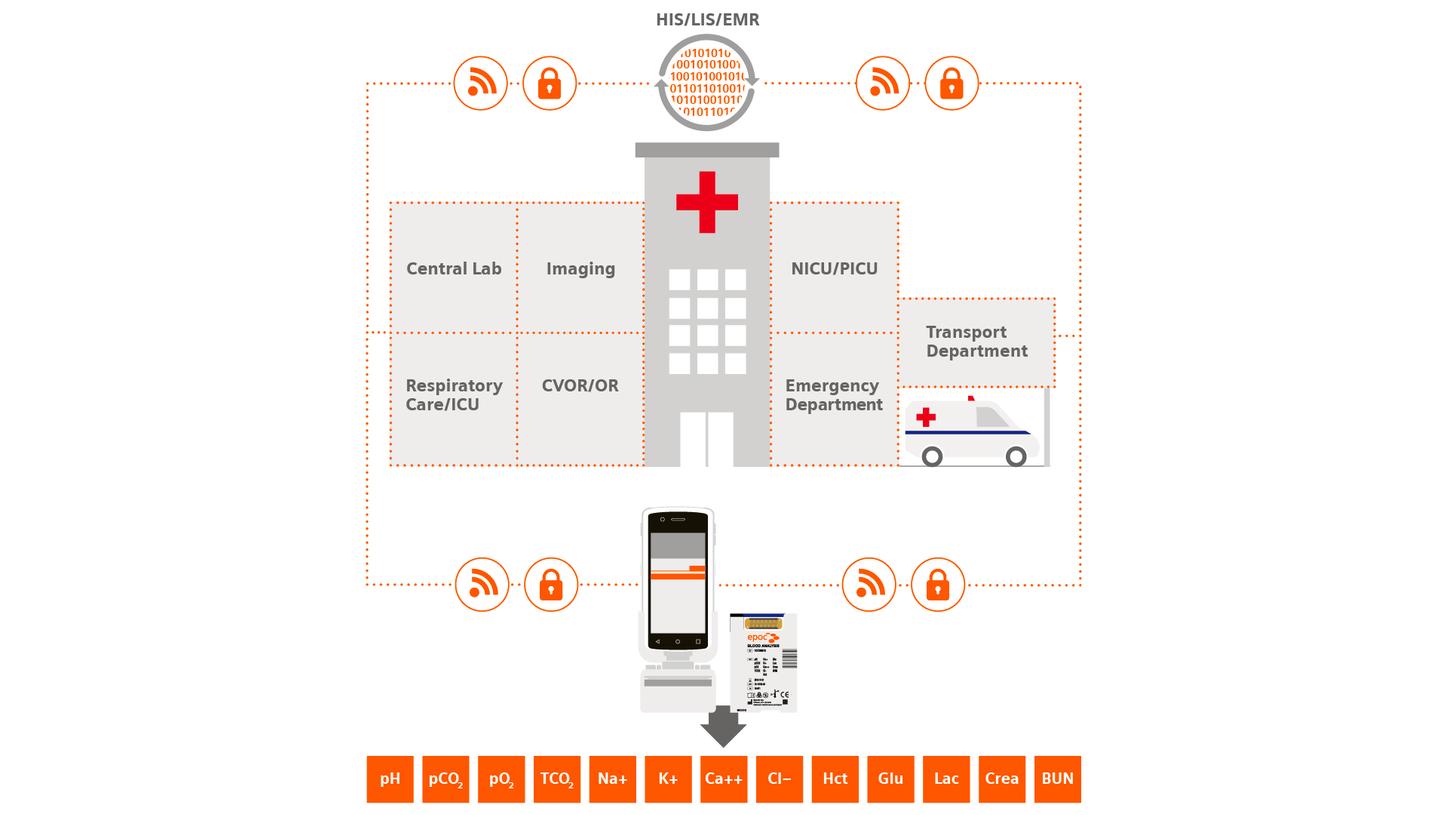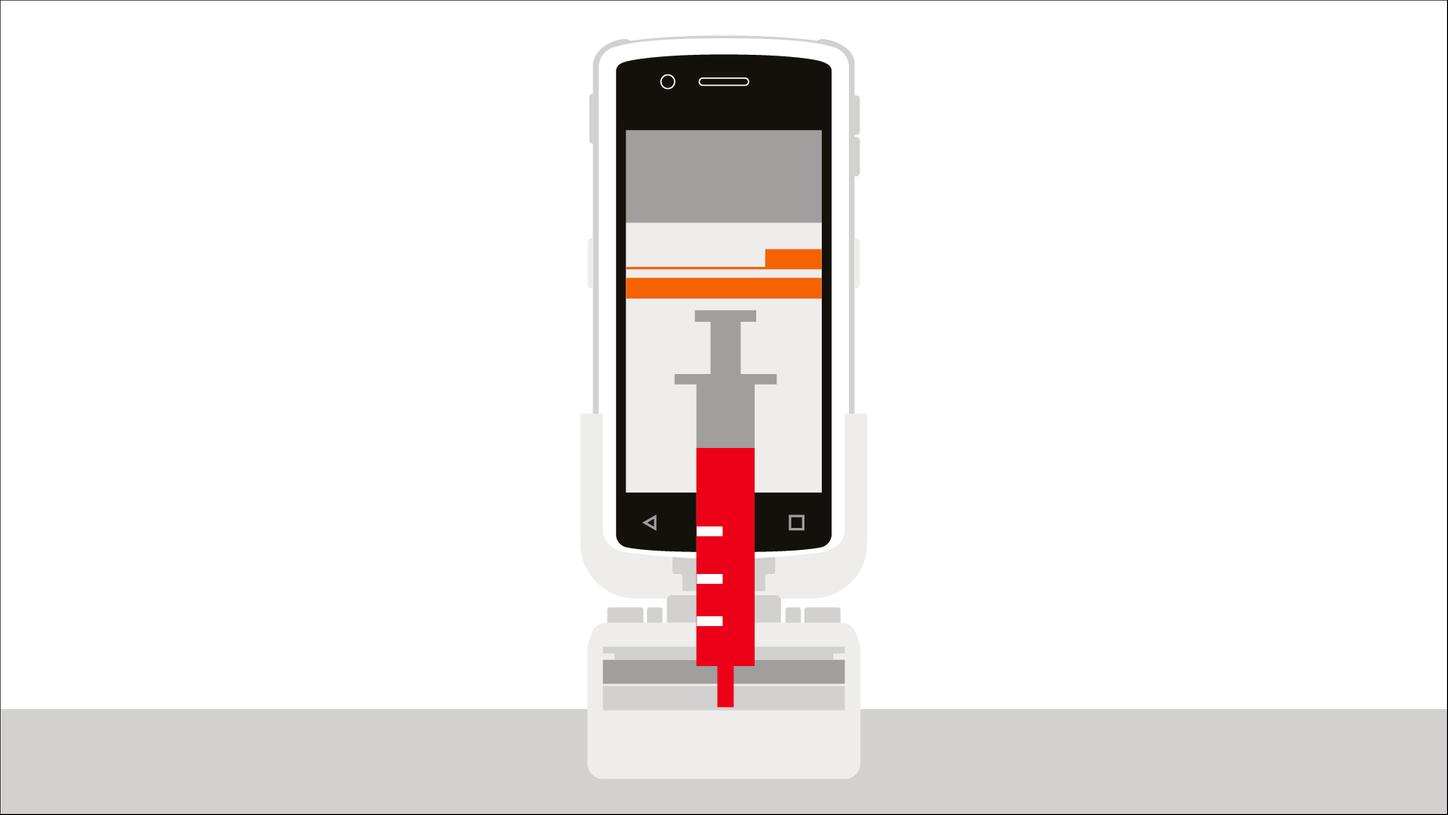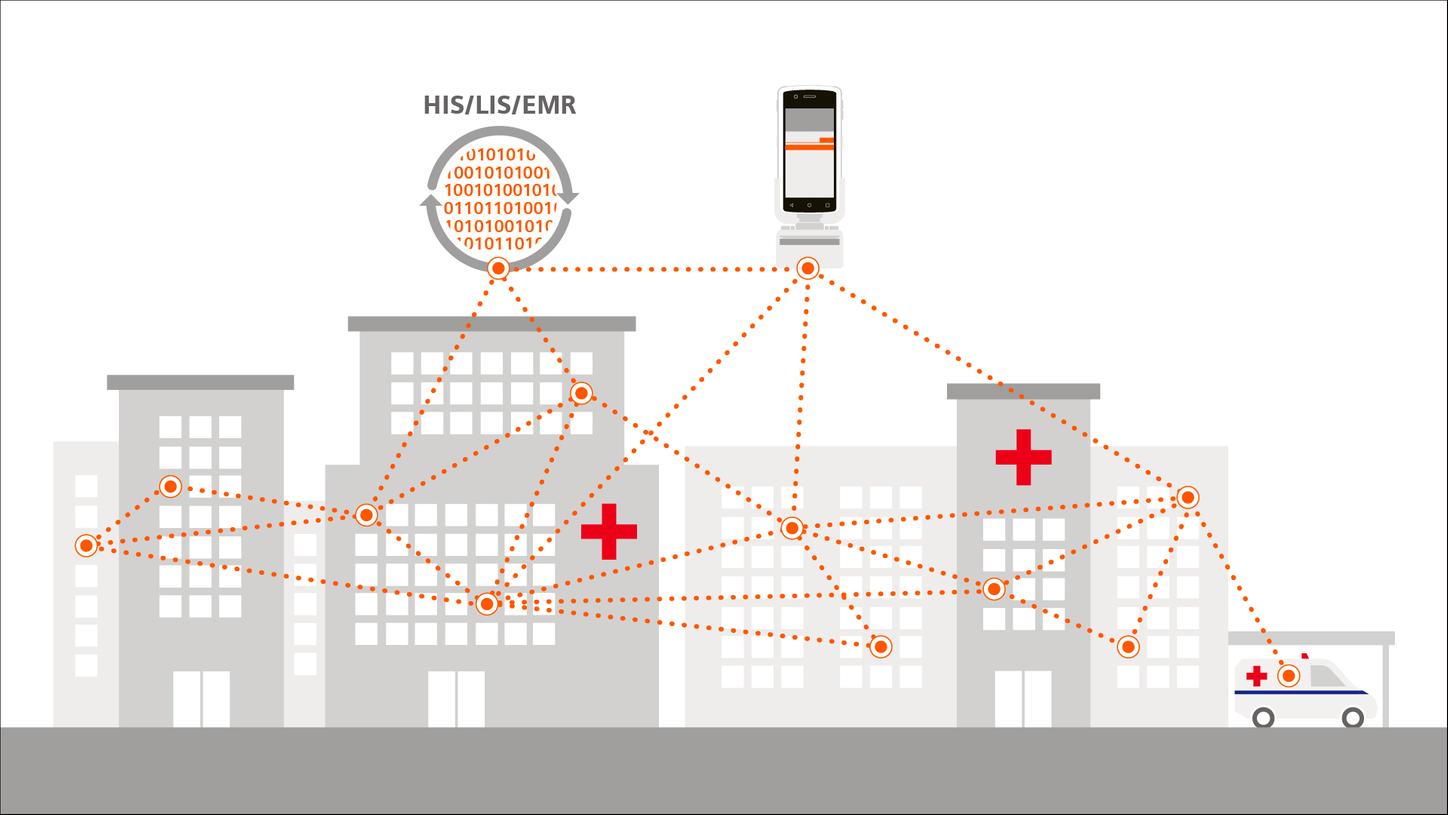- Home
- Point-of-Care Testing
- Blood Gas
- Blood Gas Systems
- epoc® Blood Analysis System with epoc® NXS Host
Advance care delivery by bringing critical testing patient-side
What could happen when critical testing results are securely delivered patient-side in less than 1 minute with a system that securely connects the entire care team?
With the epoc® Blood Analysis System as the nexus of care, caregivers and the laboratory can stay connected to what’s important—being where patients need them most.
Features & Benefits
The epoc system connects the patient, actionable test results,
the care team, and the therapy they deliver.
 POC™ EcosystemSecure Wireless ConnectionImagingNICU/PICUCentral LabEmergency/TransportRespiratory Care/ICUCVOR/ORepoc NXS Hostepoc BGEM Test Card
POC™ EcosystemSecure Wireless ConnectionImagingNICU/PICUCentral LabEmergency/TransportRespiratory Care/ICUCVOR/ORepoc NXS Hostepoc BGEM Test CardHealthcare providers spend more time with the patient to drive faster diagnosis and treatment decisions.
The epoc system lets you be where patients need you most.
The epoc system connects the entire team, so it doesn’t matter if the laboratory staff and caregivers work in different parts of the hospital. With the epoc system, they stand together to advance care delivery.
Integrated Patient Safety
Enhance patient safety with a secure, wireless connection to confirm real-time patient identification to mitigate data entry and transcription errors.
“The purpose of the 2017 National Patient Safety Goals is to improve patient safety. Two goals highlighted to address problems were to identify patients correctly and improve staff communication.”
The Joint Commission Accreditation Hospital
Integrated Patient Safety
With easy access to test cards available at the patient’s side spend less time on more complex workflows to get actionable results.
Results can be available in less than 1 minute and accurately reflect patient’s immediate condition.
“The immediate introduction at the bedside of a patient’s blood sample into an epoc test card minimizes preanalytical sample degradation.”
Clarke Woods, BS, and Dave Culton, BA. Pinnacle Health

Patient-side testing simplifies the process, eliminating sample transport and pre-analytical sample degradation to provide accurate results.
Traditional testing models require multiple steps including transport to a stationary analyzer which takes up precious time that may delay availability of results.
“We are talking 30 mins on a test and that is a STAT because that is just the process. That’s just how long it takes there’s nothing you can do about that”
Kristie Campbell, Huntsville Hospital
Transforming Care Delivery at Huntsville Hospital
Huntsville Hospital reduced their (sepsis) mortality rate by ~50% as art of a sepsis program.
“For every hour you wait to give an antibiotic, the mortality for that patient increases 8%, so now that we have the handheld device, the nurse can get those results within 3 minutes, and we know how to treat that patient.” - Carissa Hicks, RN, Huntsville Hospital
Actionable results in less than 1 minute at the patient's side.





The laboratory spends less time on complex inventory management optimizing time and resource utilization.
The epoc system lets you be where patients need you most.
Freedom to focus on where you bring the most value to patient care.
Barcoded test cards automate quality assurance and a single room temperature stable test card streamlines inventory management.
Empowered by Design
Automated quality assurance eliminating the risk of running expired reagents further mitigating risk of diagnosis and treatment based on erroneous results.
“Each reagent for the epoc has direct bar coding, ensuring easy traceability.”
Shweta Agarwal, MD, Baylor College of Medicine and Texas Children’s Hospital
Empowered by Design
Streamlined inventory management by doing away with the manual tracking of reagents once removed from refrigeration.
“The epoc system uses a single test card with all the different analytes whereas a competitor system uses multiple test cartridges for the same results. Lastly, the smart card technology of epoc reduces cost and maximizes efficiency in the hospital setting.”
Shweta Agarwal, MD, Baylor College of Medicine and Texas Children’s Hospital

Test cards are barcoded to eliminate the risk of running an expired test card.
Leverage centralized control of decentralized testing with secure, wireless communication and our POC Informatics Solutions

Connected Comprehensive Care
Manage, configure, control, and troubleshoot testing on epoc, RAPIDPoint® and RAPIDLab® blood gas systems with our POC Ecosystem™ Solution. Enable the monitoring of information from every connected analyzer, including epoc Blood Analysis Systems and test devices with more than 40 manufacturers, with our POCcelerator Data Management System.

POC Ecosystem™ Solution
Whatever your device mix and wherever critical testing takes place, Siemens Healthineers’ POC Informatics help advance workforce productivity, improve clinical workflows, satisfy compliance and accreditation requirements, and optimize the management of resources.
Assays
Measured Parameters | ||
Parameter | Unit of Measure | Measurement Range |
pH | pH units | 6.5–8.0 |
pCO2 | mmHg | 5-250 |
kPa | 0.7-33.3 | |
pO2 | mmHg | 5–750 |
kPa | 0.7–100 | |
TCO2 | mmol/L | 5-50 |
Na+ | mmol/L | 85–180 |
K+ | mmol/L | 1.5–12.0 |
Ca++ | mmol/L | 0.25–4.00 |
mg/dL | 1.0–16.0 | |
mEq/L | 0.5–8.0 | |
Cl- | mmol/L | 65–140 |
Hct | % PCV | 10–75 |
L/L | 0.10–0.75 | |
Glu | mmol/L | 1.1–38.5 |
mg/dL | 20-700 | |
g/L | 0.20-7.00 | |
Lac | mmol/L | 0.30–20.00 |
mg/dL | 2.7–180.2 | |
g/L | 0.03–1.80 | |
Crea | mg/dL | 0.30–15.00 |
μmol/L | 27–1326 | |
BUN | mg/dL | 3-120 |
Urea | mmol/L | 1.1-42.8 |
mg/dL | 7-257 | |
g/L | 0.07-2.57 |
Institutions should establish and set their own normal range values.
* Values >60 will be reported as >60 mL/min/1.73 m2.
† IDMS-traceable MDRD type
‡ CKD-EPI equation
§ Bedside Schwartz equation
Calculated Parameters | ||
Parameter | Unit of Measure | Measurement Range |
cHgb | mmol/L | 2.0-15.5 |
g/dL | 3.3-25 | |
g/L | 33-250 | |
cHCO3- | mmol/L | 1-85 |
mEq/L | ||
cTCO2 | mmol/L | 1-85 |
mEq/L | ||
BE(ecf) | mmol/L | 30 – +30 |
mEq/L | ||
BE(b) | mmol/L | -30 – +30 |
mEq/L | ||
cSO2 | % | 0-100 |
GFRmdr*† | mL/min/1.73m2 | 2–60 or >60 |
GFRmdr-a*† | mL/min/1.73m2 | 2–60 or >60 |
GFRckd‡ | mL/min/1.73m2 | 1-225 |
GFRckd-a‡ | mL/min/1.73m2 | 1-225 |
GFRswz§ | mL/min/1.73m2 | 1-275 |
AGap | mmol/L | -14 – +95 |
mEq/L | ||
AGapK | mmol/L | -10 – +99 |
mEq/L | ||
BUN/Crea | mg/mg | 0.2-400.0 |
Urea/Crea | mmol/mmol | 0.8-1615.4 |
mg/mg | 0.4-856.8 | |
A | mmHg | 5-800 |
kPa | 0.67-106.64 | |
A-a | mmHg | 1-800 |
kPa | 0.13-106.64 | |
a/A | % | 0-100 |
fraction | 0-1 |
Institutions should establish and set their own normal range values.
* Values >60 will be reported as >60 mL/min/1.73 m2.
† IDMS-traceable MDRD type
‡ CKD-EPI equation
§ Bedside Schwartz equation
Technical Details
Sample Size |
|
Sample volume | At least 92 μL |
|
|
Analysis |
|
Time to result | Less than 1 minute |
|
|
Quality Control |
|
| Eurotrol GAS-ISE Metabolites (with BUN) Eurotrol Calibration Verification Fluids (with BUN) Eurotrol Hct Control
Eurotrol Hematocrit Verification Fluid |
|
|
Test Card |
|
Calibration | Automatically performed prior to every test |
Storage | 15–30°C |
Shelf life | Up to 5 months |
|
|
Integrated Barcode Scanner |
|
| For Patient ID, Operator ID, and ampuled QC;
1D and 2D bar-code symbologies |
|
|
Operating System |
|
| Android 9.0 |
Data Security | |
Patient Data encryption Encrypted end-to-end data transmission No hard-coded password No user access to operating system | |
Communications |
|
| Real Time Wireless, LIS/HIS via data management system, POC Informatics Solutions |
Did this information help you?
Thank you.
Product availability may vary from country to country and is subject to varying regulatory requirements. Please contact your local representative for availability.